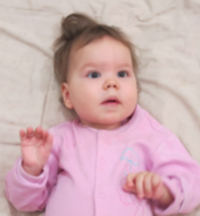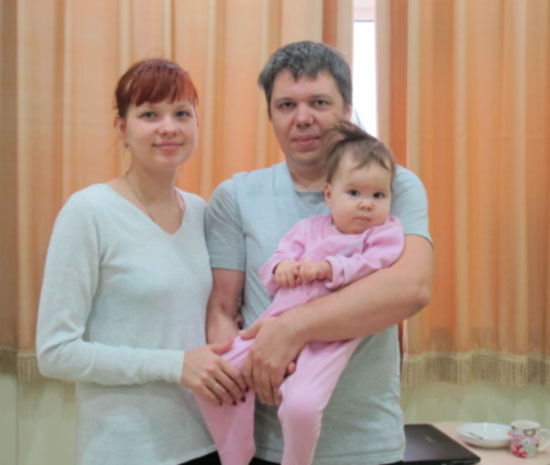Vlasov Alisa - Infantile progressive spinal muscular atrophy (Ukraine) Posted November 25,2013
Name: Vlasov Alisa 
Sex: Female
Country: Ukraine
Age: 1.5
Diagnoses: Infantile progressive spinal muscular atrophy
Admission Date: 2013-10-20
Days Admitted to Hospital: 27 days
Before treatment: Vlasov Alisa received operation to get rid of the chest hemangioma when she was 45 days. About 1 year ago, the parents found out that the baby couldn't crawl or sit-up. The MRI of head showed no abnormalities. The patient received massage and swing training but the patient's motor ability had not improved. The patient received genetic testing 8 months ago and was diagnosed with progressive spinal muscular atrophy. She received rehabilitation training. The main symptoms: progressive weakness of four limbs and trunk. She also had motor disorders in four limbs and trunk. She only could turn over to one side. The control force of head and trunk was very poor. She also suffered from breathing difficulty and swallow difficulty.
Admission PE:
Height: 83cm, Weight: 6.5Kg. Temperature: 36.6 degree, Hr: 140/min, Br: 42/min, Bp: 90/50mmHg. The skin and mucosa were normal, with no breakage or hemorrhagic spots on the skin. The thorax was not symmetrical. The breathing movement of both lungs was weak. The respiratory sounds in both lungs were low, with no obvious moist or dry rales. The heart sound was low and the cardiac rhythm was regular, with no obvious murmur. The abdomen was expanded and softened, with no palpable masses.
Nervous System Examination:
Vlasov Alisa was alert. Her language comprehension and pronunciations was very low. Her orientation, calculation abilities and insight were all normal. Both pupils were equal in size, the diameter was 3.0mms. Both eyeballs could move flexibly and the pupils reacted normally to light stimulus. There was no obvious nystagmus. The examination of the vision and the visual field were normal. She had poor control ability of her head. She could move her head when she was in horizontal position. She had weak muscle to raise her head. She was unable to shrug shoulders. The muscle strength of waist and back were weak. She was unable to sit or stand by herself. She only could change her position from lying on side to clinostatism. The muscle strength of both upper limbs' near-end was at level 0 and the far end was at level 3. The hold power of both hands was at level 3+. The muscle strength of both lower limbs was at level 1. The muscle tone of four limbs was reduced. The abdominal reflexes and tendon reflexes of all four limbs were not elicited. The bilateral palm jaw reflex was negative. The grasping reflex was negative. The bilateral Hoffmann's sign was negative. The bilateral Babinski's sign was negative. The examination of sensory was normal. She couldn't cooperate with coordination movement examination.
Treatment:
We initially gave Vlasov Alisa a complete examination, and according to her medical history, she was diagnosed with infantile progressive spinal muscular atrophy clearly. The patient received nerve regeneration treatment and stem cell activating treatment. She received treatment to strengthen the body resistance and cardiopulmonary function. She also received treatment to improve the blood circulation to increase the blood supply to the damaged neurons and nourish the nerves, this accompanied with rehabilitation training.
Post-treatment:
The patient's spirit and diet are better than before. Height: 83cm, Weight: 7.5Kg. The range of motion of both upper limbs has increased. The muscle strength of both upper limbs has increased 1-2 levels. The flexibility of both hands has increased than before and the hold power of both hands has increased than before. The muscle strength of both lower limbs has increased too. In supine position, when she bends knees, she can swing left leg and right leg. She also can bend lower limbs' far end. With some assistance, the patient can control her waist and back for several seconds. Her cry sound is stronger than before. She has improved language comprehension in recent days. The respiratory intensity is stronger than before.

